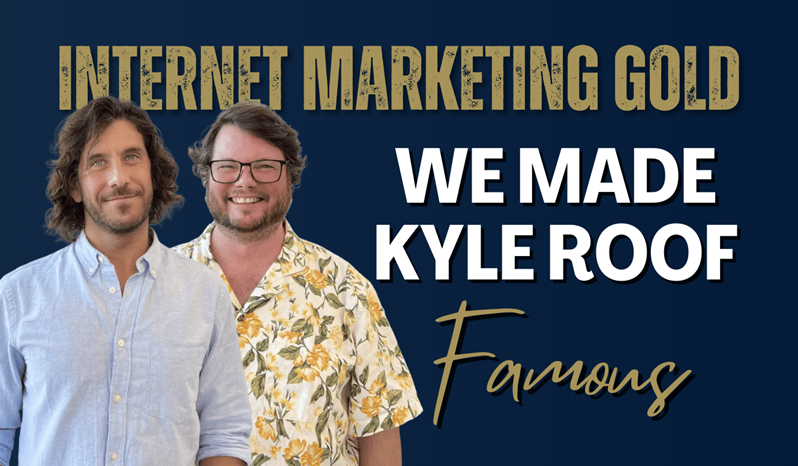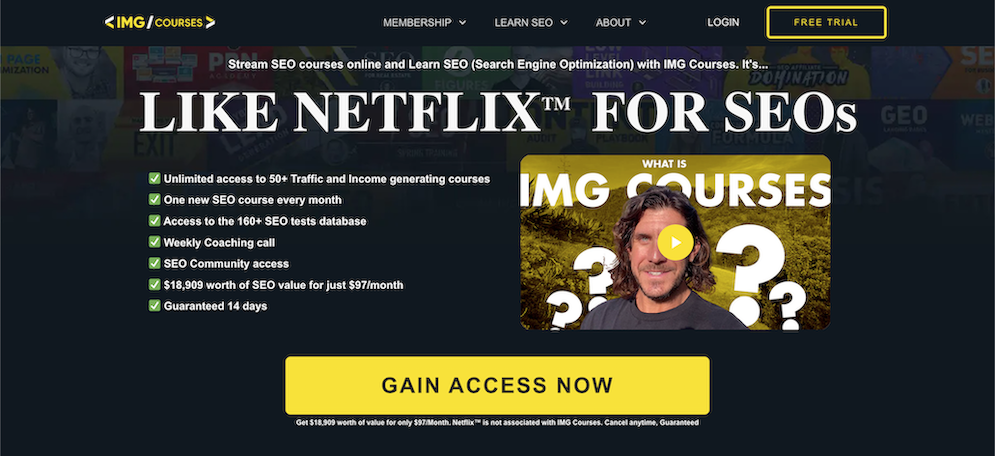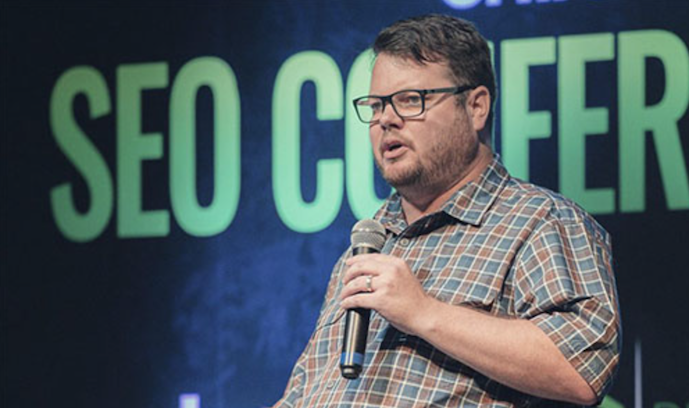
Get case studies from successful membership site founders sent straight to your inbox each week. Click the button below.
Who are you and what is your background?
My Name is Andy Steven. I’m originally from Australia but I’ve been living the expat life for 11 years.
I left Australia and I’ve been living in a few countries. At the moment I’m in Portugal but was previously in Berlin.
What is your business and when did you start it?
We’re running three businesses in parallel, actually. They’re all leveraging one another. We have 2 other businesses, a SaaS tool called Page Optimizer Pro, an agency, and this one, Internet Marketing Gold, our online SEO community. In the community, we mostly do training through courses. The model works on a membership basis.
The business is one of three businesses in the same space, so when we began we were able to leverage an existing audience, an existing following, to kind of kick start the community. It’s very hard to start a community from zero and we didn’t start our community from zero.
We transitioned from another community and we were able to get this one pretty alive even though it was small from the get go through a launch that we originally did which was a course.
The way that this business model works is that we find experienced and authoritative SEO influencers and just people with a lot of skills who are good teachers to create courses for us. Some of those are created by our team but the majority of them are created from all the people that are in our network.
They create courses and we launch a new course every month and then we sell membership access to our entire platform which includes our course library. Then there’s some other things like online events almost every week around some of the courses where we have a Q&A with some of the experts. We also have a special topic that we do round table discussions on. Also, we do testing on Google’s algorithm. We have a library of tests in which our testing team, which is sort of a group of volunteers, run tests to find out what’s a ranking factor that is helping SEO, then document their tests in a scientific way and people get access to the catalog so that they can see what they can potentially try. That’s the more cutting edge side of it.
Most people come for the courses. Most people are usually interested in 1 or 2 courses then buy a membership so they get access to all the other things as well. They might intend just to stay for one course but usually they stay for quite a lot longer.

What was your professional situation right before starting the membership site?
I needed to earn an income when I left Australia for a country where my language was foreign so coming from a background working in SEO agencies that was differently the easiest transition for me to make. I started setting up an online remote SEO agency.
Kyle, my business partner, came in not long after that and we spent the next 10 years building up an international SEO agency. We didn’t even meet until well over a year of us being in business together. We exited the agency last year and we stayed in the SEO space.
How did you get the idea to start this particular business?
It kind of happened by accident. It’s a story of rising from the ashes from a big failure through a lot of trial-and-error.
Kyle used to be in a testing group with a bunch of other SEOs just testing different things and he was the lead tester. People would just buy a membership and get access to all of the tests. That split up so we thought we’d do our own version of that.
We started building a purpose built platform for this. We invested a lot of money in doing a custom platform for running our SEO testing community and after 6 months of development we realized that it was never gonna be anywhere close to what we actually wanted. It was a stupid exercise which was just pouring good money after bad.
So we dropped the project and we decided that we needed to somehow recoup all of this lost investment and Kyle had the idea to do a course. We already had a community and we had an email list but we had no product. Kyle put together the first course, On Page SEO, because that’s what he was famous for. This complemented our SEO tool very nicely.
We did a big marketing launch to launch the course. It was a lifetime only deal and we sold about 400 copies of the course within a couple of weeks. That recouped all of the investment we initially lost.
We were like, “What’s this courses thing? Maybe we’re onto something here.” So, we tried to do another one that someone else created.
What was the major challenge you faced in starting or scaling it and how did you overcome it?
Our business model back then was that we had a list and an audience, so we should do launches for other people as a joint venture and split the profit. We were running launches every month and it was so much work. Everyone was just ridiculously burnt out so we realized it wasn’t sustainable and we needed an evergreen product to keep inviting people to, a marketing funnel that we didn’t have to rebuild from scratch every single month and could keep running like a flywheel.
My background is as a marketer so my idea was to build a product that sort of runs itself and then just invest in marketing. We decided that the model would be to get as many courses as possible into a platform and then sell access to the platform. I’ve been running that model for 3 years.
We have an evergreen model in place, an evergreen funnel in place, but also the best of both worlds because we still do launches but we’re not solely reliant on the sales we get from those monthly coarse drops every month. We’ve got recurring income every month.
What was growth like over the first couple of years?
It’s been stable but not astronomical. We’ve doubled a couple of times since the beginning. It doesn’t seem like astronomical growth or anything. We started it about 3 years ago. [Editor’s note: Two doublings amounts to 300% growth over 3 years… and we think that’s very good growth.]
What was your specific strategy for growing it and how did you implement that?
The biggest leverage strategy was that we kind of made Kyle famous. A lot of that was the fact that Kyle is an excellent SEO, a great communicator, and a people pleaser when he goes on stage. We could see that he was resonating with people so we spent a lot of our time and money on building up Kyle’s brand.

That involved mostly getting Kyle interviewed on podcasts and YouTube channels, stuff like that. It’s quite targeted in the audiences we’re choosing.
The influence just kind of grew from there. That influence has definitely been the biggest factor in growth, scaling, reputation, and just being able to do effective outreach.
The majority of people who come to us find Kyle on one of those platforms, then look into who he is because they like what he said. They see the course, and the learning platform. They join because of the course then stay for the other value offerings within the membership.
There’s a lot of other influential instructors as well. If you look up these instructors by name, maybe it’s because you heard them interviewed somewhere or maybe saw them at a conference. If you look them up by name via organic search then you’ll find a course.
Then running online events that’s been a big one old as well. We used to have a monthly show where we would interview one of our instructors. It would be an interview and then a workshop format so they would actually teach something from their course. We’d do a lot of outreach via our email list and just cold outreach on various platforms to try and get people to register for the live event and then we’d run it and try to sell the people who registered memberships.
We leveraged Kyle’s past success to get on podcasts – that compounds over time. Once you become well known within one vertical and outgrow it, you can go more broad and bring the reputation from the vertical that you’ve already dominated into a new more general area.
We started in just SEO but we flooded that fairly quickly and we needed to speak to other audiences, for instance SaaS marketers, business owners and operators, decision makers, and technical businesses.
A lot of people actually come into the platform they sign up for our membership and are not SEOs and have no intention of being SEOs but they know they’ve got an SEO problem in their business that they need to solve. For them the first step is to learn a little bit about it so they can have conversations and work out who to hire so they don’t get taken advantage of. They may also look to our instructors in our platform who are running their own businesses as potential service providers. That’s kind of an unintended audience that has come through this.
Lately, we’ve done paid ads with mixed success. On the whole it’s been worth it. You have really good weeks followed by really bad weeks and it balances out. Sometimes they run a profit and, even if they don’t, you’re growing your list which hopefully is a warm, warm list.
Ads are like putting a rocket engine under whatever you are doing. Organic growth is slow and painful but it’s great for generating content. Then you can take bits of that content and turn them into ads and get them out to 100x the number of people in a quarter of the time.
For us to be successful, it comes down to building offers, testing different ways to get people into the platform, and doing our best to ensure the value of becoming an active member.
That’s the most profitable part of it, when you get someone that is sticky, who stays around for at least 6 months, adds value inside of the community, consumes the content, and hopefully tells his friends.
But ads is really something I would really advise once you’re pretty established and you have good cash flow. It’s very expensive and if you’re not doing it well. You can burn through your cash reserves very quickly and then you won’t be able to run ads anymore because you’re not able to pay for them.
How much money is the business making now and what is the revenue mix?
It’s a pretty simple product. The majority of people are just on monthly memberships at a cost of $97. But, there are occasional special offers that we run and we also sell lifetime access to each individual course, so you can buy just one course for life but can’t access other courses through that package. That’s a very small percentage of our revenue coming from that individual course offering.
We’re sitting at 1000 members with a 17000 person email list. Our revenue is sitting a little under seven figures yearly.
If you were advising someone on starting a similar company today, what would you tell them is the key area to focus on and which strategy should they use to address it?
I think there needs to be a face behind a brand like this. People don’t really trust brands or companies – people trust people. And, usually a person has to have a track record related to the service offering.
If they can then develop that into a following – and that’s probably the most important part because, it’s sort of like link juice, you can use the trust from one person to pass that onto other people, as well, when building your product.
Some platforms, or some membership platforms, all of the content is developed just by the core team and then others outsource it to different people, like in the case of IMG. But, every course is more or less endorsed by someone the prospect trusts.
It’s also a very high churn business model. It’s something that people should be aware of. Content gets old quickly and people lose interest quickly.
Time is the biggest scarcity factor that most people have. You can’t get around the fact that you need time for training. It tends to fall to the bottom of people’s list of priorities when they’re running their businesses.
Churn’s the biggest challenge that you’ll face with a model like ours, a recurring subscription model. It’s not like a SaaS product where it’s almost impossible to leave because you’ve got all your data in there, you’ve got your team in there, you’re actively using a tool which is bringing in profits every month. It’s not as sticky as that. It’s just not.
We’ve tried a lot of things to try and create this stickiness. There’s a certain percentage of your audience that will relate to that, it will serve them, but the majority of people… their lives are already full so they’re not looking for another community.
What’s next for you?
We’re at the point now where we’re just trying to scale. Our other businesses are established and fairly predictable at this point in time. We just need to test different strategies for product, for offerings, and just double down on what’s working.
With these sorts of businesses, it’s very expensive to build the product but it’s not that expensive to scale it. We don’t need many more resources to run the business with twice as many members.
At this point, it’s not been a hugely profitable business and the only way for it to become a really profitable business is to triple our membership community so that’s what our big focus is in the coming year.
I’d just like to add that a lot of it has just been a hard slog by Kyle. He’s always on, he’s traveling constantly to wherever he gets invited to around the world. He just has to get out and create his personal brand and that’s really hard work that most people just can’t do. Our job behind the scenes of doing outreach and adding fuel to the fire is the easy part.
Get case studies from successful membership site founders sent straight to your inbox each week. Click the button below.


